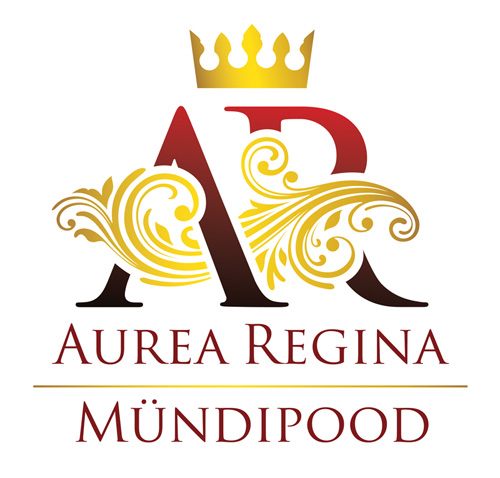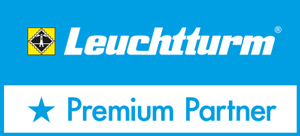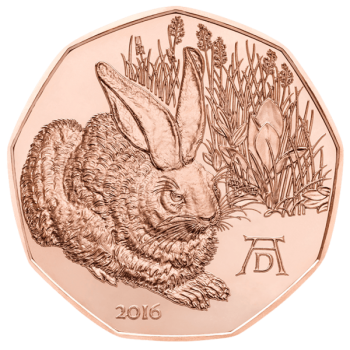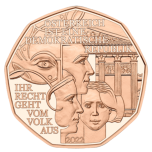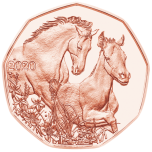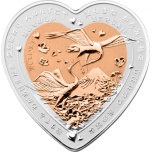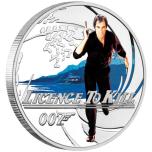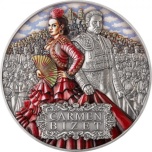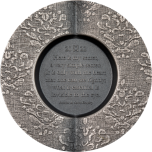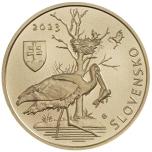Dürer's Young hare. Austria 5 € 2016 copper coin, 8,5 g
Price:
15,00 €
Quality: Special Uncirculated
Face Value: 5 Euro
Diameter: 28,5 mm
Copper: 99,9%
Total Weight: 8,5 g
Comes without packaging
It may be more than half a millennium since it was painted but Albrecht Dürer’s ‘Young Hare’ still has an uncanny ability to move and fascinate. Probably the most famous depiction of an animal in the history of European art, the magnificent watercolour shows all the cuddly characteristics that have led this shy and lovable creature to take its place in Middle-European Easter tradition − and make it the ideal subject for our delightful Easter coin.
Durable Dürer
Painted in Dürer’s workshop in Nuremberg in 1502, the ‘Feldhase’, as it is called in German, is the most iconic painting in the vast collection of Vienna’s Albertina museum. Another of Dürer’s masterpieces of observational art in the Albertina collection is the ‘Great Piece of Turf’, which forms the background to the hare on the coin’s reverse, above Dürer’s famous monogram. Painted with almost photographic accuracy, both watercolours are testament to the genius of their creator, whose powers of observation have never been equalled. A Renaissance man, both literally and figuratively, Albrecht Dürer 1471-1528 has been compared to Leonardo da Vinci for the breadth and depth of his artistic and intellectual pursuits. He was a printmaker, engraver and theorist, as well as a painter who pioneered the self-portrait, yet his watercolour of a hare is perhaps his most recognisable work. How he managed to capture such a detailed image of a wild and constantly moving animal remains a mystery, which no doubt adds to the enduring allure of the ‘Young Hare’.
Face Value: 5 Euro
Diameter: 28,5 mm
Copper: 99,9%
Total Weight: 8,5 g
Comes without packaging
It may be more than half a millennium since it was painted but Albrecht Dürer’s ‘Young Hare’ still has an uncanny ability to move and fascinate. Probably the most famous depiction of an animal in the history of European art, the magnificent watercolour shows all the cuddly characteristics that have led this shy and lovable creature to take its place in Middle-European Easter tradition − and make it the ideal subject for our delightful Easter coin.
Durable Dürer
Painted in Dürer’s workshop in Nuremberg in 1502, the ‘Feldhase’, as it is called in German, is the most iconic painting in the vast collection of Vienna’s Albertina museum. Another of Dürer’s masterpieces of observational art in the Albertina collection is the ‘Great Piece of Turf’, which forms the background to the hare on the coin’s reverse, above Dürer’s famous monogram. Painted with almost photographic accuracy, both watercolours are testament to the genius of their creator, whose powers of observation have never been equalled. A Renaissance man, both literally and figuratively, Albrecht Dürer 1471-1528 has been compared to Leonardo da Vinci for the breadth and depth of his artistic and intellectual pursuits. He was a printmaker, engraver and theorist, as well as a painter who pioneered the self-portrait, yet his watercolour of a hare is perhaps his most recognisable work. How he managed to capture such a detailed image of a wild and constantly moving animal remains a mystery, which no doubt adds to the enduring allure of the ‘Young Hare’.
Sarnased tooted
Quality: Uncirculated
Face Value: 5 Euro
Diameter: 28,5 mm
Material: Copper
Total Weight: 8,9 g
Mintage: 200 000
A coin the likes of which Austria has never seen before, Democracy is made from copper from the former roof of the Parliament building in Vienna. When you purchase the coin you therefore acquire a little piece of democracy and by spending 5 euros you get something priceless in return.
On the occasion of the reopening of the Parliament building in Vienna, we are issuing this very special coin. The copper it contains originally formed part of the former roof of the building but was removed during the ongoing renovation of the building. By using it to make the copper edition of the Democracy coin, we are making our democratic tradition something tangible. A strong democracy thrives on discourse. Our opinions may differ, but our consensus is democracy. Likewise, fundamental rights and freedoms make a democracy what it is. They enable individual and social freedom and guarantee the co-determination of the individual.
The coin’s reverse features two heads in profile and one full face, which represent the people as sovereign. To the left, we see a watchful eye surrounded by stylised laurel leaves, to the right, we see a section of the Austrian Parliament building in the background. But much more than this, the coin illustrates the spirit from which our nation was born. This is reflected in the Austrian Constitution, where it says: "Austria is a democratic republic. Its law emanates from the people." These wise words appear on the top and bottom edges of the coin.
Face Value: 5 Euro
Diameter: 28,5 mm
Material: Copper
Total Weight: 8,9 g
Mintage: 200 000
A coin the likes of which Austria has never seen before, Democracy is made from copper from the former roof of the Parliament building in Vienna. When you purchase the coin you therefore acquire a little piece of democracy and by spending 5 euros you get something priceless in return.
On the occasion of the reopening of the Parliament building in Vienna, we are issuing this very special coin. The copper it contains originally formed part of the former roof of the building but was removed during the ongoing renovation of the building. By using it to make the copper edition of the Democracy coin, we are making our democratic tradition something tangible. A strong democracy thrives on discourse. Our opinions may differ, but our consensus is democracy. Likewise, fundamental rights and freedoms make a democracy what it is. They enable individual and social freedom and guarantee the co-determination of the individual.
The coin’s reverse features two heads in profile and one full face, which represent the people as sovereign. To the left, we see a watchful eye surrounded by stylised laurel leaves, to the right, we see a section of the Austrian Parliament building in the background. But much more than this, the coin illustrates the spirit from which our nation was born. This is reflected in the Austrian Constitution, where it says: "Austria is a democratic republic. Its law emanates from the people." These wise words appear on the top and bottom edges of the coin.
15,00 €
Quality: Special Uncirculated
Face Value: 5 Euro
Diameter: 28,5 mm
Copper: 99,9%
Total Weight: 8,5 g
Comes without packaging
Few animals have had a bigger impact on humans than the horse. Its power, beauty and sensitivity make the horse one of the most beloved members of the animal kingdom, not least among young female riders, many of whom form a profound and enduring bond with their loyal steed. The Easter Coin 2020 celebrates this unique bond.
From being the subject of countless prehistoric cave paintings, to the leading form of human transport for more than five millennia, the horse has played an unparalleled role in the development of society. The most iconic of all European horse breeds is the Lipizzaner, made world famous through its connection with the Spanish Riding School in Vienna. Originally from Slovenia, the Lipizzaner has been bred since 1920 at the stud farm at Piber in the Austrian province of Styria, where some 40 foals come into the world every year. Within minutes of their birth, new born foals can stand and, though initially unsteady, are soon galloping joyfully across the alpine meadows.
The coin features a foal in the foreground frolicking happily through a meadow while its mother keeps a watchful eye close behind. The lower part of the coin is decorated with an assortment of spring flowers.
Face Value: 5 Euro
Diameter: 28,5 mm
Copper: 99,9%
Total Weight: 8,5 g
Comes without packaging
Few animals have had a bigger impact on humans than the horse. Its power, beauty and sensitivity make the horse one of the most beloved members of the animal kingdom, not least among young female riders, many of whom form a profound and enduring bond with their loyal steed. The Easter Coin 2020 celebrates this unique bond.
From being the subject of countless prehistoric cave paintings, to the leading form of human transport for more than five millennia, the horse has played an unparalleled role in the development of society. The most iconic of all European horse breeds is the Lipizzaner, made world famous through its connection with the Spanish Riding School in Vienna. Originally from Slovenia, the Lipizzaner has been bred since 1920 at the stud farm at Piber in the Austrian province of Styria, where some 40 foals come into the world every year. Within minutes of their birth, new born foals can stand and, though initially unsteady, are soon galloping joyfully across the alpine meadows.
The coin features a foal in the foreground frolicking happily through a meadow while its mother keeps a watchful eye close behind. The lower part of the coin is decorated with an assortment of spring flowers.
15,00 €
Similar products
Face value: 1 $Fiji
Silver: 99.9%
Total weight: 37,4 g (21,4 g silver)
Mintage: 5,000
Japanese cranes are strictly monogamous. Once they become mates, they can maintain their marriage for life. Therefore, in Japan and other countries, Japanese cranes are regarded as a symbol of monogamous love. Male and female in pairs, intimate, together foraging, or standing together in pairs, inseparable, In the breeding season, the male and female pairs spread their wings and draw their necks and dance lightly. The graceful dancing posture is fascinating. The text on the outer ring quotes famous Japanese poet Kiyohara no Motosuke "Today the tears are full of sleeves, still think mutually firm. Love is like a wave that swallows the pine mountains" --Mibu no Tadami "I fall in love,The rumor already Goes around.Though I began to Give my heart to her secretly. Love is not known, this desire alone dark acacia"
Silver: 99.9%
Total weight: 37,4 g (21,4 g silver)
Mintage: 5,000
Japanese cranes are strictly monogamous. Once they become mates, they can maintain their marriage for life. Therefore, in Japan and other countries, Japanese cranes are regarded as a symbol of monogamous love. Male and female in pairs, intimate, together foraging, or standing together in pairs, inseparable, In the breeding season, the male and female pairs spread their wings and draw their necks and dance lightly. The graceful dancing posture is fascinating. The text on the outer ring quotes famous Japanese poet Kiyohara no Motosuke "Today the tears are full of sleeves, still think mutually firm. Love is like a wave that swallows the pine mountains" --Mibu no Tadami "I fall in love,The rumor already Goes around.Though I began to Give my heart to her secretly. Love is not known, this desire alone dark acacia"
129,00 €
Silver: 99.99%
Nominal value 0.5TVD
Weight: 15.553g
Dimensions: 32.60 mm
Maximum Mintage 12,007
Coin Finish Proof
Created by former intelligence officer and author Ian Fleming in 1953, James Bond is a fearless, charismatic and deadly British Secret Service agent with a ‘licence to kill’. Also known by the codename 007, he has been portrayed by six actors – Sean Connery, George Lazenby, Roger Moore, Timothy Dalton, Pierce Brosnan and Daniel Craig – in 25 thrilling movies released by EON Productions since 1962.
Diamonds Are Forever design
In Diamonds Are Forever, released in 1971, Bond tracks SPECTRE boss Blofeld to the US where he discovers his evil nemesis is stockpiling diamonds to power a space-based laser weapon. Played by Sean Connery, 007 must neutralise the satellite and prevent the supervillain from carrying out his latest threat to global stability.
The coin’s reverse depicts a coloured illustration of James Bond, the charismatic Secret Service agent. Based on an official movie poster, the design also features a moon buggy 007 uses to escape across the Nevada Desert. Included on the reverse are the iconic gun barrel graphic from the franchise’s signature opening sequence, the famous 007 gun logo and the inscription ‘DIAMONDS ARE FOREVER’.
Branded display packaging and numbered certificate
Individual releases from the James Bond Official 25-Coin Collection are each housed in a 007 branded case with a transparent acrylic top and a movie themed shipper. Each coin is accompanied by a Certificate of Authenticity featuring poster artwork.
Nominal value 0.5TVD
Weight: 15.553g
Dimensions: 32.60 mm
Maximum Mintage 12,007
Coin Finish Proof
Created by former intelligence officer and author Ian Fleming in 1953, James Bond is a fearless, charismatic and deadly British Secret Service agent with a ‘licence to kill’. Also known by the codename 007, he has been portrayed by six actors – Sean Connery, George Lazenby, Roger Moore, Timothy Dalton, Pierce Brosnan and Daniel Craig – in 25 thrilling movies released by EON Productions since 1962.
Diamonds Are Forever design
In Diamonds Are Forever, released in 1971, Bond tracks SPECTRE boss Blofeld to the US where he discovers his evil nemesis is stockpiling diamonds to power a space-based laser weapon. Played by Sean Connery, 007 must neutralise the satellite and prevent the supervillain from carrying out his latest threat to global stability.
The coin’s reverse depicts a coloured illustration of James Bond, the charismatic Secret Service agent. Based on an official movie poster, the design also features a moon buggy 007 uses to escape across the Nevada Desert. Included on the reverse are the iconic gun barrel graphic from the franchise’s signature opening sequence, the famous 007 gun logo and the inscription ‘DIAMONDS ARE FOREVER’.
Branded display packaging and numbered certificate
Individual releases from the James Bond Official 25-Coin Collection are each housed in a 007 branded case with a transparent acrylic top and a movie themed shipper. Each coin is accompanied by a Certificate of Authenticity featuring poster artwork.
79,00 €
Face Value: 5 Dollars
Weight 2 oz
Silver: 999
Diameter 50 mm
Quality Antique Finish
Issuing Country: Niue
Year Date: 2022
Mintage: 500
This silver coin portrays Bizet's opera, Carmen, with a beautiful antique finish with succinct details of performers and observers. Carmen is an opera masterpiece that combines symphony, harmony, atmosphere, and orchestration in musical brilliance. The coin features in the Titan of music series, a numismatic hub of genius trans generational musical artists and their works. This perfect coinage artistic product resonates with an important history in music and must be collectors' most desirable coin!
Weight 2 oz
Silver: 999
Diameter 50 mm
Quality Antique Finish
Issuing Country: Niue
Year Date: 2022
Mintage: 500
This silver coin portrays Bizet's opera, Carmen, with a beautiful antique finish with succinct details of performers and observers. Carmen is an opera masterpiece that combines symphony, harmony, atmosphere, and orchestration in musical brilliance. The coin features in the Titan of music series, a numismatic hub of genius trans generational musical artists and their works. This perfect coinage artistic product resonates with an important history in music and must be collectors' most desirable coin!
299,00 €
Country: Cook Island
Face value: 5 Dollars
Silver: 99,9%
Weight: 1 oz
Diameter: 35 mm
Quality: Antique finish
Mintage: 2022
Technique: smartminting® (Ultra High Relief)
This coin reveals the most amazing wealth of our life: LOVE.
To feel love towards someone or something is priceless. This piece of art will trigger emotions and give birth to a smile when you turn it in your hand and the magic happens.Enjoy this moment again and again and find the matching quote of «The little prince», which complements this unique symbol of love. Who will get your Secret Heart?
Face value: 5 Dollars
Silver: 99,9%
Weight: 1 oz
Diameter: 35 mm
Quality: Antique finish
Mintage: 2022
Technique: smartminting® (Ultra High Relief)
This coin reveals the most amazing wealth of our life: LOVE.
To feel love towards someone or something is priceless. This piece of art will trigger emotions and give birth to a smile when you turn it in your hand and the magic happens.Enjoy this moment again and again and find the matching quote of «The little prince», which complements this unique symbol of love. Who will get your Secret Heart?
189,00 €
Face value: 5 €
Diameter: 34 mm
Weight: 19.1 g
Metal: Brass
Mintage: 40,000
The black stork is an unmistakable bird species. The adult has mainly black plumage with white underparts, long coral red legs and a long pointed beak. The beak and eye areas are the same colour as the legs, and the black plumage has an intense greenish-purple sheen. Adults weigh between around 2.4 kg and 3.2 kg. Black storks are distributed throughout most of Europe and Asia, and most forest areas of Slovakia are nesting sites for these birds. They typically nest in mature deciduous and mixed forests, preferring areas with wetlands and watercourses where they can forage for food. They select large trees with strong horizontal branches and show high fidelity to breeding sites and nesting trees. The base of the nest is formed by thick branches, while the interior is lined with twigs, clumps of grass, lichens and moss. The female lays two to four eggs. Both parents feed the fledglings by regurgitating food onto the nest floor. Black storks feed on smaller fish, amphibians, insects, gastropods, small mammals and small birds. They migrate to wintering grounds mainly in August and September. In Slovakia, the black stork is a protected species.
Obverse:
The obverse of the euro collector coin depicts a black stork hunting on a body of water. In the background is a tree with a stork’s nest. An adult stork is depicted flying towards a chick in the nest, carrying food in its beak. On the upper left side is the Slovak coat of arms and, above it, the year of issuance ‘2023’. On the right side is the mint mark of the Kremnica Mint (Mincovňa Kremnica), consisting of the letters ‘MK’ placed between two dies. Inscribed along part of the right edge is the name of the issuing country ‘SLOVENSKO’.
Reverse:
The reverse design depicts a black stork taking flight. To the right of this image are the denomination ‘5’ and currency ‘EURO’, one above the other. In the lower part of the design, next to the stork’s legs, are the stylised initials ‘MŠ’, referring to the coin’s designer Marie Šeborová. Inscribed along the lower edge and separated by a medial dot are the Slovak and scientific names for the black stork: ‘BOCIAN ČIERNY’ and ‘CICONIA NIGRA’.
Diameter: 34 mm
Weight: 19.1 g
Metal: Brass
Mintage: 40,000
The black stork is an unmistakable bird species. The adult has mainly black plumage with white underparts, long coral red legs and a long pointed beak. The beak and eye areas are the same colour as the legs, and the black plumage has an intense greenish-purple sheen. Adults weigh between around 2.4 kg and 3.2 kg. Black storks are distributed throughout most of Europe and Asia, and most forest areas of Slovakia are nesting sites for these birds. They typically nest in mature deciduous and mixed forests, preferring areas with wetlands and watercourses where they can forage for food. They select large trees with strong horizontal branches and show high fidelity to breeding sites and nesting trees. The base of the nest is formed by thick branches, while the interior is lined with twigs, clumps of grass, lichens and moss. The female lays two to four eggs. Both parents feed the fledglings by regurgitating food onto the nest floor. Black storks feed on smaller fish, amphibians, insects, gastropods, small mammals and small birds. They migrate to wintering grounds mainly in August and September. In Slovakia, the black stork is a protected species.
Obverse:
The obverse of the euro collector coin depicts a black stork hunting on a body of water. In the background is a tree with a stork’s nest. An adult stork is depicted flying towards a chick in the nest, carrying food in its beak. On the upper left side is the Slovak coat of arms and, above it, the year of issuance ‘2023’. On the right side is the mint mark of the Kremnica Mint (Mincovňa Kremnica), consisting of the letters ‘MK’ placed between two dies. Inscribed along part of the right edge is the name of the issuing country ‘SLOVENSKO’.
Reverse:
The reverse design depicts a black stork taking flight. To the right of this image are the denomination ‘5’ and currency ‘EURO’, one above the other. In the lower part of the design, next to the stork’s legs, are the stylised initials ‘MŠ’, referring to the coin’s designer Marie Šeborová. Inscribed along the lower edge and separated by a medial dot are the Slovak and scientific names for the black stork: ‘BOCIAN ČIERNY’ and ‘CICONIA NIGRA’.
14,90 €
